1.2 What is Science?
Created by: CK-12/Adapted by: Christine Miller

Ouch!
The person in Figure 1.2.1 is getting a flu vaccine. You probably know that getting a vaccine can hurt — but it’s usually worth it. A vaccine contains dead or altered forms of germs that normally cause a disease, such as flu or measles. The germs in vaccines have been inactivated or weakened so they can no longer cause illness, but are still “noticed” by the immune system.
They stimulate the immune system to produce chemicals that can kill the actual germs if they enter the body, thus preventing future disease. How was such an ingenious way to prevent disease discovered? The short answer is more than two centuries of science.

Science as Process
You may think of science as a large and detailed body of knowledge, but science is also the process by which this knowledge is obtained. Science uses experimentation, evidence, and logic to continuously test ideas. Over time and through repeated experimentation and testing, scientific knowledge advances.
We’ve been accumulating knowledge of vaccines for more than two centuries. The discovery of the first vaccine, as well as the process of vaccination, dates back to 1796. An English doctor named Edward Jenner observed that people who became infected with cowpox did not get sick from smallpox, a similar but much more severe disease (Figure 1.2.2). Jenner decided to transmit cowpox to a young boy to see if it would protect him from smallpox. He gave the boy cowpox by scratching liquid from cowpox sores into the boy’s skin. Then, six weeks later, he scratched liquid from smallpox sores into the boy’s skin. As Jenner predicted, the boy did not get sick from smallpox. Jenner had discovered the first vaccine, although additional testing was needed to show that it really was effective.
Almost a century passed before the next vaccine was discovered, a vaccine for cholera in 1879. Around the same time, French chemist Louis Pasteur found evidence that many human diseases are caused by germs, which earned him the title of “father of germ theory.” Since Pasteur’s time, vaccines have been discovered for scores of additional diseases caused by germs, and scientists are currently researching vaccines for many others.
Benefits of Science
Medical advances such as the discovery of vaccines are one of the most important benefits of science, but science and scientific knowledge are also crucial for most other human endeavors. Science is needed to design safe cars, predict storms, control global warming, develop new technologies of many kinds, help couples have children, and put humans on the moon. Clearly, the diversity of applications of scientific knowledge is vast!
1.2 Summary
- Science is a large and detailed body of knowledge. It is also the process by which this knowledge is obtained.
- Science uses experimentation, evidence, and logic to continuously test ideas. Over time and through repeated experimentation and testing, scientific knowledge advances.
- Medical advances such as the development of vaccines are one of the most important benefits of science, but science and scientific knowledge are also crucial for most other human endeavors.
1.2 Review Questions
- Explain why science is considered both a process and a body of knowledge.
- State three specific examples of human endeavors that are based on scientific knowledge.
- How does science influence your daily life?
- Jenner used a young boy as a research subject in his smallpox vaccine research. Today, scientists must follow strict guidelines when using human subjects in their research. What unique concerns do you think might arise when human beings are used as research subjects?
- What gave Jenner the idea to develop a vaccine for smallpox?
- Why do you think almost a century passed between the development of the first vaccine (for smallpox) and the development of the next vaccine (for cholera)
1.2 Explore More
https://www.youtube.com/watch?time_continue=1&v=yqUFy-t4MlQ&feature=emb_logohttps://www.ted.com/talks/uri_alon_why_science_demands_a_leap_into_the_unknown?language=en
How we conquered the deadly smallpox virus – Simona Zompi, TED-Ed, 2013.
Attributions
Figure 1.2.1
Vacina, centro de vacinação, by Hyttalo Souza on Unsplash, used under the Unsplash License (https://unsplash.com/license).
Figure 1.2.2
Child with Smallpox/ID#3265, by CDC/ James Hicks, from the Centre for Disease Control and Prevention, is in the public domain (https://en.wikipedia.org/wiki/Public_domain).
References
TED-Ed. (2013, October 28). How we conquered the deadly smallpox virus – Simona Zompi. YouTube. https://www.youtube.com/watch?v=yqUFy-t4MlQ&feature=youtu.be
Wikipedia contributors. (2020, August 9). Edward Jenner. In Wikipedia. https://en.wikipedia.org/w/index.php?title=Edward_Jenner&oldid=971970576
Wikipedia contributors. (2020, August 5). Louis Pasteur. In Wikipedia. https://en.wikipedia.org/w/index.php?title=Louis_Pasteur&oldid=971330056
A large body of knowledge and the process by which this knowledge is obtained.

